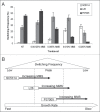To switch or not to switch?: Phenotypic switching is sensitive to multiple inputs in a pathogenic fungus
- PMID: 20195457
- PMCID: PMC2829826
- DOI: 10.4161/cib.2.6.9487
To switch or not to switch?: Phenotypic switching is sensitive to multiple inputs in a pathogenic fungus
Abstract
Candida albicans is the most commonly isolated human fungal pathogen and uses a diverse repertoire of morphological transitions to aid colonization and infection. In a recent paper we discuss how one of these transitions, the white-to-opaque switch, is affected both by cell stress and by several other conditions that change the rate of cell growth. Based on our findings, we propose that the master regulator of the white-to-opaque switch, WOR1, acts as a sensitive monitor of both intrinsic and environmental conditions.
Keywords: Candida albicans; WOR1; epigenetic; genotoxic stress; oxidative stress; white-opaque switch.
Figures

Comment on
-
Stress-induced phenotypic switching in Candida albicans.Mol Biol Cell. 2009 Jul;20(14):3178-91. doi: 10.1091/mbc.e09-01-0040. Epub 2009 May 20. Mol Biol Cell. 2009. PMID: 19458191 Free PMC article.
Similar articles
-
MTL-independent phenotypic switching in Candida tropicalis and a dual role for Wor1 in regulating switching and filamentation.PLoS Genet. 2013 Mar;9(3):e1003369. doi: 10.1371/journal.pgen.1003369. Epub 2013 Mar 21. PLoS Genet. 2013. PMID: 23555286 Free PMC article.
-
Role of the WOR1 Promoter of Candida albicans in Opaque Commitment.mBio. 2021 Oct 26;12(5):e0232021. doi: 10.1128/mBio.02320-21. Epub 2021 Sep 7. mBio. 2021. PMID: 34488444 Free PMC article.
-
Bistable expression of WOR1, a master regulator of white-opaque switching in Candida albicans.Proc Natl Acad Sci U S A. 2006 Aug 22;103(34):12813-8. doi: 10.1073/pnas.0605270103. Epub 2006 Aug 11. Proc Natl Acad Sci U S A. 2006. PMID: 16905649 Free PMC article.
-
Environmental pH adaption and morphological transitions in Candida albicans.Curr Genet. 2016 May;62(2):283-6. doi: 10.1007/s00294-015-0540-8. Epub 2015 Nov 18. Curr Genet. 2016. PMID: 26581628 Review.
-
Phenotypic switch: The enigmatic white-gray-opaque transition system of Candida albicans.J Oral Maxillofac Pathol. 2017 Jan-Apr;21(1):82-86. doi: 10.4103/0973-029X.203781. J Oral Maxillofac Pathol. 2017. PMID: 28479692 Free PMC article. Review.
Cited by
-
Comparative genomics of white and opaque cell states supports an epigenetic mechanism of phenotypic switching in Candida albicans.G3 (Bethesda). 2021 Feb 9;11(2):jkab001. doi: 10.1093/g3journal/jkab001. G3 (Bethesda). 2021. PMID: 33585874 Free PMC article.
-
The role of phenotypic switching in the basic biology and pathogenesis of Candida albicans.J Oral Microbiol. 2014 Jan 15;6. doi: 10.3402/jom.v6.22993. eCollection 2014 Jan 15. J Oral Microbiol. 2014. PMID: 24455104 Free PMC article. Review.
-
Milbemycins: more than efflux inhibitors for fungal pathogens.Antimicrob Agents Chemother. 2013 Feb;57(2):873-86. doi: 10.1128/AAC.02040-12. Epub 2012 Dec 3. Antimicrob Agents Chemother. 2013. PMID: 23208712 Free PMC article.
-
Differential phytate utilization in Candida species.Mycopathologia. 2011 Dec;172(6):473-9. doi: 10.1007/s11046-011-9453-3. Epub 2011 Jul 27. Mycopathologia. 2011. PMID: 21792623
-
Transcriptional Circuits Regulating Developmental Processes in Candida albicans.Front Cell Infect Microbiol. 2020 Dec 3;10:605711. doi: 10.3389/fcimb.2020.605711. eCollection 2020. Front Cell Infect Microbiol. 2020. PMID: 33425784 Free PMC article. Review.
References
-
- Bennett RJ, Johnson AD. Mating in Candida albicans and the search for a sexual cycle. Ann Rev Micro. 2005;59:233–255. - PubMed
Grants and funding
LinkOut - more resources
Full Text Sources
